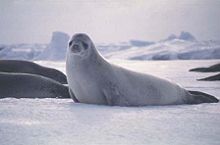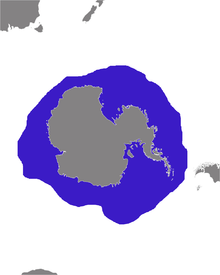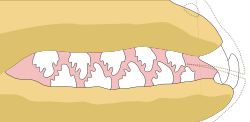- Crabeater seal
-
Crabeater seal 
Conservation status Scientific classification Kingdom: Animalia Phylum: Chordata Class: Mammalia Order: Carnivora Superfamily: Pinnipeda Family: Phocidae Tribe: Lobodontini Genus: Lobodon Species: L. carcinophagus Binomial name Lobodon carcinophagus
Hombron & Jacquinot, 1842
Distribution of crabeater seal The crabeater seal, Lobodon carcinophagus, is a true seal with a circumpolar distribution around the coast of Antarctica. They are medium to large-sized (over 2 m in length), relatively slender and pale-colored, found primarily on the free floating pack ice that extends seasonally out from the Antarctic coast, which they use as a platform for resting, mating, social aggregation and accessing their prey. They are by far the most abundant seal species in the world. While population estimates are uncertain, there are at least 7 million and possibly as many as 75 million individuals.[2] This success of this species is due to its specialized predation on the abundant Antarctic krill of the Southern Ocean, for which it has uniquely adapted sieve-like tooth structure. Indeed, its scientific name, translated as "lobe-toothed (lobodon) crab eater (carcinophagus)", refers specifically to the finely-lobed teeth adapted to filtering their small crustacean prey.[3] As well as an important krill predator, the crabeater seal is an important component of the diet of leopard seals (Hydrurga leptonyx), which consume about 80% of all crabeater pups.
Contents
Taxonomy and evolution
The crabeater seal shares a common recent ancestor with the other Antarctic seals, which are together known as the lobodontine seals. These include the Ross seal (Ommatophoca rossii), leopard seal (Hydrurga leptonyx) and Weddell seal (Leptonychotes weddelli).[4] These species, collectively belonging to the Lobodontini tribe of seals, share teeth adaptations including lobes and cusps useful for straining smaller prey items out of the water column. The ancestral Lobodontini likely diverged from its sister clade, the Mirounga (elephant seals) in the late Miocene to early Pliocene, when they migrated southward and diversified rapidly in relative isolation around Antarctica.[4]
Distribution and population
Crabeater seals have a continuous circumpolar distribution surrounding Antarctica, with only occasional sightings or strandings in the extreme southern coasts of South America, Africa, Australia and New Zealand.[3] They spend the entire year on the pack ice zone as it advances and retreats seasonally, primarily staying within in the continental shelf area in waters less than 600m deep.[5] They colonized Antarctica during the late Miocene or early Pliocene (15 - 25 million years ago), at a time when the region was much warmer than today. The population is connected and fairly well mixed (panmictic), and genetic evidence does not suggest any subspecies separations.[6]
There are no current reliable estimates of the total crabeater seal population. Past estimates relied on minimal opportunistic sighting and much speculation, ranging from 2 million[7] to 50-75 million individuals.[8] The most recent point estimate is 7 million individuals[9] but this, too, is considered a likely underestimate.[1] An international effort, the Antarctic Pack Ice Seal initiative (APIS), is currently underway to evaluate systematically collected survey data and obtain reliable estimates of all Antarctic seal abundances.[3]
Physical description
Adult seals (over five years old) grow to an average length of 230 cm (7.6 ft) and an average weight of around 200 kg (440 lbs). Females are on average 6 cm (2.5 in) longer and around 8 kg heavier than males on average, though their weights fluctuate substantially according to season: females can lose up to 50% of their body weight during lactation, and males lose a significant proportion of weight as they attend to their mating partners and fight off rivals.[10] Large crabeater seals can weigh up to 300 kg (660 lbs).[11] Pups are about 120 cm in length and 20 and 30 kilograms at birth. While nursing, pups grow at a rate of about 4.2 kilograms a day, and can weigh as much as 100 kg by the time they are weaned after only two to three weeks.[12]
Pups are born with a light brown, downy pelage (lanugo), until the first molt at weaning. Younger animals are marked by net-like, chocolate brown markings and flecks on the shoulders, sides and flanks, shading into the predominantly dark hind and fore flippers[13] and head, often due to scarring from leopard seals. After molting, the fur of the crabeater seal is a darker brown fading to blonde on its belly. The fur lightens throughout the year, becoming completely blonde in summer. Older animals become progressively paler, even when freshly molted, and may appear almost white.[3]
Crabeaters have relatively slender bodies and long skulls and snouts compared to other phocids. Perhaps their most distinctive adaptation is the unique dentition that enables this species to sieve Antarctic krill. The postcanine teeth are finely divided with multiple cusps. Together with the tight fit of the upper and lower jaw, a bony protuberance near the back of the mouth completes a near-perfect sieve within which krill are trapped.[3]
Behavior
Crabeater seals have an atypical, serpentine gait when on ice or land, combining retractions of the foreflippers with undulations of the lumbar region.[2] This method of locomotion leaves a distinctive sinuous body track and can be extremely effective. When not subject to overheating (i.e. on cold days), speeds on land of 19–26 km/h (12-16 mph) have been recorded for short distances.[2] Satellite tracking data have resulted in conservative estimates of swimming speeds of 66 km/day and 12.7 km/h. While swimming, crabeaters have been known to engage in porpoising (leaping entirely out of the water) and spyhopping (raising the body vertically out of the water for visual inspection) behaviors.[2]
The most gregarious of the Antarctic seals, crabeaters have been observed on the ice in aggregations of up to 1,000 hauled out animals and in swimming groups of several hundred individuals, breathing and diving almost synchronously. These aggregations consist primarily of younger animals. Adults are more typically encountered alone or in small groups of up to three on the ice or in the water.[3]
Crabeater seals give birth during the Antarctic spring from September to December.[14] Rather than aggregate in reproductive rookeries, females haul out on ice to give birth singly. Adult males attend female-pup pairs until the female begins estrous one to two weeks after the pup is weaned before mating. Copulation has not been observed directly and presumably occurs in water. Pups are weaned in approximately three weeks,[15] at which time they are also beginning to molt into a subadult coat similar to the adult pelage.[2]
Curiously, crabeater seals have been known to wander further inland than any other pinniped. Carcasses have been found over 100 km from the water and over 1000 m above sea level, where they can be mummified in the dry cold air and conserved for centuries.[16]
Ecology
Diet
Despite its name, the crabeater seal does not feed on crabs, which are not found in its Antarctic habitat. Rather, the crabeater seal is a specialist predator on Antarctic krill (Euphausia superba), which comprise over 90% of the diet.[2] Their high abundance is a testament to the extreme success of Antarctic krill, the single species with the greatest biomass on the planet.[17] There is little seasonality in their prey preference, but they may target adult and male krill.[2] Other prey items include cephalopods and diverse Antarctic fish species.[2] Although the crabeater seal is sympatric with the other Antarctic seal species (Weddell, Ross and leopard seals), the specialization on krill minimizes interspecific food competition. Among krill-feeding whales, only blue whales (Balaenoptera musculus) and minke whales (B. acutorostrata) extend their range as far south as the pack ice where the crabeater seal are most frequent.[2]
While there are no reliable historical population estimates, population models suggest crabeater seal populations may have increased at rates up to 9% a year in the 20th century, due to the removal of large baleen whales (especially the blue whale) during the period of industrial whaling and the subsequent explosion in krill biomass and removal of important competitive forces.[18]
Predation
Crabeater seals experience significant predation by leopard seals. Indeed, first year mortality is exceedingly high, possibly reaching 80%, and up to 78% of crabeaters that survive through their first year have injuries and scars from leopard seal attacks.[1] Long scars and sets of parallel scars, visible on the otherwise pale and relatively unmarked pelage of crabeaters, are present on nearly all young seals. The incidence of visible scars falls off significantly after the first year, suggesting leopard seals primarily target the young of the year.[19] The high predation pressure has clear impacts on the demography and life history of crabeater seals, and has likely had an important role in shaping social behaviors, including aggregation of subadults.[2]
Predation by killer whales (Orcinus orca) is poorly documented, though all ages are hunted.[20] While most predation occurs in the water, coordinated attacks by groups of killer whales creating a wave to wash the hauled-out seal off floating ice have been observed.[21]
Gallery
See also
Other Antarctic seal species include:
- Leopard seal (Hydrurga leptonyx)
- Ross seal (Ommatophoca rossii)
- Weddell seal (Leptonychotes weddellii)
References
- ^ a b c Southwell, C. (2008). Lobodon carcinophaga. In: IUCN 2008. IUCN Red List of Threatened Species. Downloaded on 28 January 2009.
- ^ a b c d e f g h i j Adam, P.J. (2005) Lobodon carcinophaga Mammalian Species No. 772, pp. 1–14
- ^ a b c d e f Bengtson, J. A. (2002). Crabeater seal Lobodon carcinophaga. In: W. F. Perrin, B. Wursig, and J. G. M. Thiewissen. (eds), Encyclopedia of marine mammals, pp. 302-304. Academic Press, London, UK.
- ^ a b Fyler, C.A.; Reeder, T.W.; Berta, A.; Antonelis, G.; Aguilar, A.; Androukaki (2005), "Historical biogeography and phylogeny of monachine seals (Pinnipedia: Phocidae) based on mitochondrial and nuclear DNA data", Journal of Biogeography 32: 1267–1279
- ^ Burns, J., Costa, D., Fedak, M., Hindell, M., Bradshaw, C., Gales, N., McDonald, B., Trumble, S. & Crocker, D. (2004). Winter habitat use and foraging behavior of crabeater seals along the Western Antarctic Peninsula. Deep Sea Research Part II: Topical Studies in Oceanography 51 (17-19), 2279-2303.
- ^ Davis C, Stirling I, Strobeck C (2000) Genetic diversity of Antarctic pack ice seals in relation to life history characteristics. In: Antarctic Ecosystems: Models for Wider Ecological Understanding (eds Davison W, Howard-Williams C, Broady P), pp. 56-62. The Caxton Press, Christchurch, New Zealand.
- ^ Scheffer, V. B. (1958). Seals, sea lions and walruses: A review of the Pinnipedia. Stanford University Press, Stanford, USA.
- ^ Erickson, A. W., Siniff, D. B., Cline, D. R. and Hofman, R. J. (1971). Distributional ecology of Antarctic seals. In: G. Deacon (ed.), Symposium on Antarctic Ice and Water Masses, pp. 55-76. Sci. Comm. Antarct Res., Cambridge, UK.
- ^ Erickson, A. W. and Hanson, M. B. (1990). Continental estimates and population trends of antarctic ice seals. In: K. R. Kerry and G. Hempel (eds), Antarctic Ecosystems. Ecological change and conservation, pp. 253-264. Springer-Verlag, Heidelberg, Germany.
- ^ Laws, R., Baird, A. & Bryden, M. (2003). Size and growth of the crabeater seal Lobodon carcinophagus (Mammalia: Carnivora). Journal of Zoology 259 (01), 103-108.
- ^ [1] (2011).
- ^ Shaughnessy, P. & Kerry, K. (2006). Crabeater seals Lobodon carcinophagus during the breeding season: observations on five groups near Enderby Land, Antarctica. Marine Mammal Science 5 (1), 68-77.
- ^ Peter Saundry. 2010. [2]. eds. C.Michael Hogan and Cutler Cleveland Encyclopedia of Earth. National Council for Science and the Environment. Washington DC
- ^ Southwell, C., Kerry, K., Ensor, P., Woehler, E. J. and Rogers, T. (2003). The timing of pupping by pack-ice seals in East Antarctica. Polar Biology 26: 648-652.
- ^ Southwell, C., Paxton C. G. M., Borchers, D., Boveng, P. and de la Mare, W. (2008). Taking account of dependent species in management of the Southern Ocean krill fishery: estimating crabeater seal abundance off east Antarctica. Journal of Applied Ecology 45: doi:10.1111/j.1365-2664.2007.01399.x.
- ^ Stirling, I. and Kooyman, G.L. (1971). The crabeater seal (Lobodon carcinophagus) in McMurdo Sound, Antarctica, and the origin of the mummified seals. Journal of Mammalogy. 52, 175-180.
- ^ Nicol, S., Endo, Y. (1997). Fisheries Technical Paper 367: Krill Fisheries of the World. FAO. http://www.fao.org/docrep/003/w5911e/w5911e00.htm.
- ^ Mori, M. & Butterworth, D. (2006). A first step towards modelling the krill-predator dynamics of the Antarctic ecosystem. CCAMLR Science 13, 217-277.
- ^ Siniff, D.B. and Bengston, J.L. (1977). Observations and hypotheses concerning the interactions about crabeater seals, leopard seals and killer whales. Journal of Mammalogy. 58,414-416.
- ^ Siniff, D. B. (1991). An overview of the ecology of Antarctic seals. American Zoologist 31:143–149.
- ^ Smith, T. G., D. B. Siniff, R. Reichle and S. Stone. (1981). Coordinated behavior of killer whales (Orcinus orca) hunting a crabeater seal, Lobodon carcinophagus. Canadian Journal of Zoology 59:1185–1189.
Categories:- IUCN Red List least concern species
- True seals
- Fauna of Antarctica
- Mammals of Western Australia
- Mammals of South Australia
- Mammals of New South Wales
- Mammals of Victoria (Australia)
- Megafauna of Australia
- Megafauna
Wikimedia Foundation. 2010.






